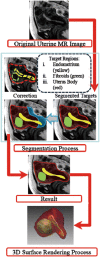Magnetic resonance imaging of uterine fibroids: a preliminary investigation into the usefulness of 3D-rendered images for surgical planning
- PMID: 26240782
- PMCID: PMC4516148
- DOI: 10.1186/s40064-015-1170-9
Magnetic resonance imaging of uterine fibroids: a preliminary investigation into the usefulness of 3D-rendered images for surgical planning
Abstract
Purpose: This study aimed to assess the efficacy of 3D surface-rendered (SR) magnetic resonance (MR) images for surgical planning of uterine fibroids.
Methods: Ten patients with uterine fibroids underwent 3D volume isotropic turbo spin-echo acquisition (VISTA) sequences in sagittal planes. SR images showing the uterine body, endometrium, and fibroids were extracted from the raw MR data. The preoperative assessment for fertility-preserving fibroid enucleation was independently performed by two gynecologists using 2D sagittal and 3D SR images separately.
Results: The required interpretation times [second] for sagittal versus SR images were 19.7 ± 9.5 versus 10.4 ± 5.1 for observer 1 (p < 0.05) and 47.5 ± 12.3 versus 19.7 ± 9.5 for observer 2 (p < 0.01). The accuracy rates of the planned surgical procedures from sagittal versus SR images were 50 versus 70% for observer 1 and 70 versus 70% for observer 2. The accuracy rates of the numbers of fibroids to be removed from sagittal versus SR images were 70 versus 80% for observer 1 and 70 versus 80% for observer 2.
Conclusion: Compared with sagittal images, SR images could significantly reduce the time required for surgical planning of uterine fibroids without sacrificing the accuracy of the preoperative assessment.
Keywords: 3D; Fibroid; Magnetic resonance imaging; Uterus.
Figures




References
LinkOut - more resources
Full Text Sources
Other Literature Sources
Research Materials

